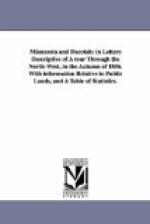LETTER X.
Valley of the red river of the north.
Climate of Minnesota— The settlement at Pembina— St. Joseph— Col. Smith’s expedition— Red River of the North— Fur trade— Red River Settlement— The Hudson’s Bay Company— Ex-Gov. Ramsey’s observations— Dacotah.
Crow Wing, October, 1856.
A celebrated geographer of the first century wrote, “Germany is indeed habitable, but is uninhabited on account of the cold.” I am not so certain, but some people have a similar idea of the upper portion of Minnesota. If there are any, however, thus distrustful of its climate, they probably live out of the territory. I have no means of knowing what the climate is here in winter, except from hearsay and general principles. It seems to be an approved theory, that the farther we approach the west in a northern latitude the milder becomes the winter. The stage-drivers tell me that the snow does not fall to such a depth as in the northern part of New England; that the weather is tolerably uniform; and that the roads are at all times kept open and much travelled. After all, it is a great way before we come to the home of the Esquimaux, and the desert of ice where Sir John Franklin perished.
I will here subjoin the following extract from a letter addressed to Gov. Stephens by the Hon. Henry M. Rice, the able delegate from Minnesota. It is dated 3d June, 1854:
“Navigation of the Mississippi River closes from the 10th to the 25th of November, and opens from the 1st to the 10th of April. That of the Red River of the North closes from the 1st to 16th November, and opens from 10th to 25th April. I have often travelled in the winter from St. Paul to Crow Wing, a distance of one hundred and fifty miles, with a single horse and sled, without a track, and have never found the snow deep enough to impede my progress. I have also gone from Crow Wing, beyond the head waters of the Mississippi, to the waters of the Hudson’s Bay, on foot and without snow-shoes. I spent one entire winter travelling through that region, and never found the snow over eighteen inches deep, and seldom over nine inches.




